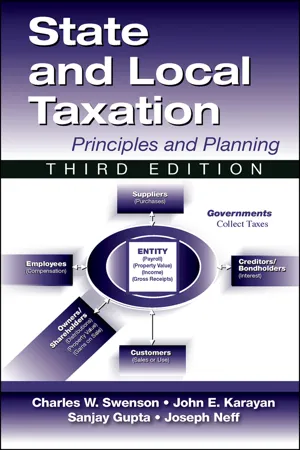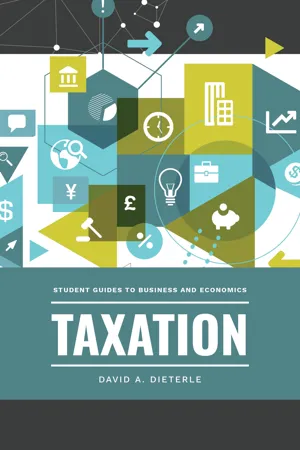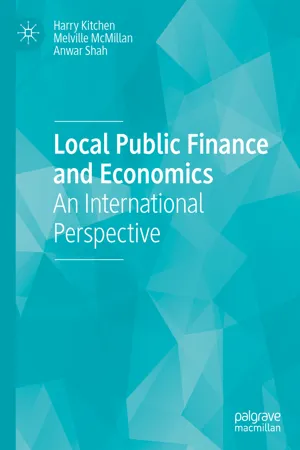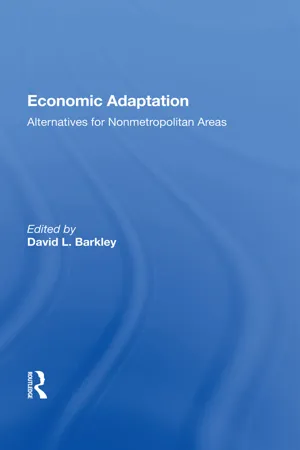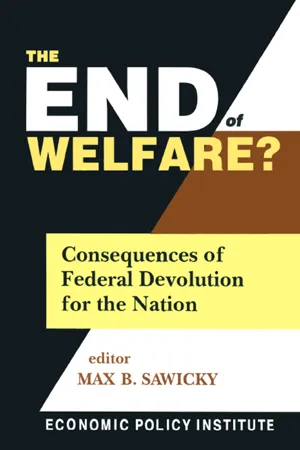Economics
State and Local Tax
State and local taxes are levied by state and local governments to fund public services and infrastructure. These taxes can include income taxes, sales taxes, property taxes, and various other fees and assessments. They play a crucial role in funding education, public safety, transportation, and other essential services at the state and local levels.
Written by Perlego with AI-assistance
Related key terms
6 Key excerpts on "State and Local Tax"
- eBook - ePub
State and Local Taxation
Principles and Practices, 3rd Edition
- Sanjay Gupta, John Karayan, Joseph Neff, Charles Swenson(Authors)
- 2020(Publication Date)
- J. Ross Publishing(Publisher)
The force that is driving the need to understand (and use) State and Local Tax knowledge is largely a function of the dynamism—some would say chaos—that is, in turn, driving state and local public finances in the information age. Simply put, technological advances have made it much easier to sell goods and services from remote locations. Traditionally, businesses without property or employees that are physically present in a jurisdiction cannot be taxed by it. This has meant a possible erosion of state and local bases when brick-and-mortar stores are replaced by e-tailers. At the same time, state and local politicians have clamored for greater tax revenues to finance increased spending for pensions and payroll, not to mention education, safety, and health care. The importance of State and Local Taxes also is a result of massive changes in federal tax laws during the past three decades.There are several reasons for this. Although state and local income tax laws now conform to the federal laws more than ever, stubborn nonconformity coupled with significant increases in State and Local Tax rates have greatly increased the relative burden of State and Local Taxes. Furthermore, quite a bit of the state legislation that is conforming to the federal approach has taken affect after a time lag (even as many states automatically linked their tax law to that of the federal government). In addition, there is the impact of a broader reach for the individual alternate minimum tax (AMT). State and Local Taxes are nondeductible for the individual AMT. This increases their after-tax cost, which has raised the cost of doing business, particularly for owners of businesses operating as flow-through entities such as Subchapter S corporations, limited liability companies, or partnerships.The years of federal tax reform that focused on widening the tax base—for example, 1981 through 1991—created a windfall of state and local income taxes. The reverse occurred when the pendulum swung the other way over the next quarter century. Although headline individual tax rates increased, the federal tax base was eroded for some taxpayers with new deductions. More important, multinational firms, spurred by the U.S. having one of the highest business income tax rates in the developed world until 2018, have been motivated to employ transfer pricing tools to significantly move taxable income outside the U.S. For many jurisdictions, these changes also eroded the state and local income tax base. (Masked by enhanced revenues from employee stock options and stock market profit taking in boom years, the ensuing return to normal patterns has revealed shortfalls in State and Local Taxable income that had been building.) - eBook - ePub
Governing Partners
State-local Relations In The United States
- Russell L Hanson(Author)
- 2018(Publication Date)
- Routledge(Publisher)
5The Politics of State-Local Fiscal Relations Jeffrey M. StonecashThe finances of state and local governments are closely connected. The states have legal control of local financial practices and provide much of the revenue of local governments. The states also are responsible for the creation of multiple local governments, which differ greatly in local tax bases that support services. The limited resources of local governments and disparities of tax bases often produce calls for states to do more to help their local governments. These demands have led to a gradual but steady expansion of state involvement in local affairs during the twentieth century. This growth has been accelerated by actions of the national government. However, the rate and timing of expansion varies from state to state, reflecting patterns of party control.The Entanglement of State and Local Finances
State and local finances are fundamentally intertwined. Legally speaking, local governments depend on state government. State governments create counties, municipalities, towns, villages, school districts, and special districts. The state also grants each of these local governments the power to tax and borrow. This power is used in almost all states to regulate what kinds of taxes may be imposed, maximum levels of taxation and debt, and what kinds of borrowing may occur (ACIR 1978; Stonecash 1981b; Kenyon 1989).The states also determine which level of government can use various kinds of taxes. States generally reserve the income tax for state use. The sales tax is also a state tax, though many states allow local governments to impose additional percentages of the sales tax for local use. Property taxes are generally reserved for local governments.States regulate how local property taxes can be applied. There are limits on what properties local governments can tax. Many properties are declared tax exempt because the organization owning land is nonprofit and a political determination has been made that such organizations should not pay taxes. For this reason, state governments grant exemptions to churches, elementary and secondary schools, higher education institutions, neighborhood groups, and a large array of social service groups such as the Red Cross, public television, youth organizations, and religious charities. These exemptions from property taxes limit the ability of local governments to raise money within their boundaries. - 4 At the state level, education also includes higher education funding, although it is decreasing as a percentage of a state’s budget. Significant expenditures on social welfare programs, including Medicaid and other assistance for less fortunate families, are approximately another one-third of state and local budgets.Local taxes and the public goods and services they provide impact our daily lives. Local taxes pay for everything from the clean water we drink, the local roads you or your parents drive on, the local library and public schools, and the local police and fire departments that protect us. In many communities, the local taxes are also used to collect garbage, keep the streets clean (including snow removal for those who live in the north), and provide sewers and drains for waste and water.Politicians in Washington, D.C., and state capitals determine federal and state taxes and spending. Taxpayers vote for the representatives but not directly for the taxes. At the local level, however, taxpayers have direct access to the vote on local issues. They can use their access to the local ballot box to express their views on the overall satisfaction with the economy or how governments are functioning, resulting in local issues becoming the scorecard for how governments are serving the taxpayers.TAXES PROVIDE PUBLIC GOODS AND SERVICESAs discussed in chapter 1 , the primary purpose of taxes is to provide public goods and services. One of the key decisions of a society relative to taxes becomes which goods and services are going to be public goods paid for by taxes, and which goods and services will be private goods paid for by individual consumers. We will discuss other purposes for taxes later in the book.In a market economy, there are two questions used to determine whether a good or service qualifies as a possible public good. The first is whether someone is excluded from using the good or service. Second is whether several (or many) individuals use the good and service at the same time, enjoying its benefits without interfering with each other. Let us explore each of these individually.
- eBook - ePub
Local Public Finance and Economics
An International Perspective
- Harry Kitchen, Melville McMillan, Anwar Shah(Authors)
- 2019(Publication Date)
- Palgrave Macmillan(Publisher)
2012 ).As well, limits on local taxes may be required if, at some limit, they account for a disproportionately higher share of the overall tax rate (local plus senior levels of government), thus creating impediments for senior levels of government who are responsible for overall macroeconomic management.Limits are also placed on local income tax rates in some US taxing jurisdictions. As for general sales tax in the United States, most states have imposed upper limits on the local rates that may be set. These limits, by and large, have been introduced to prevent local tax authorities from encroaching on state taxes as well as preventing harmful intermunicipal tax competition.Do Local Personal Income and General Sales Taxes Affect Behavior?
If local taxes have no impact on where people shop, work, and live, they are said to be neutral or economically efficient. If, as is almost always the case, the introduction of a new local tax or the increase in a local tax rate causes people to change their behavior, it may lead to distortions or inefficiencies. At the outset, it must be noted that distortionary (inefficient) taxes or tax increases are not always bad or undesirable, however. In fact, they may be necessary to remove or reduce a previous unwanted distortion or inefficiency. An illustration of this may be taken from road use in any large urbanized area. In almost all of these areas, motor vehicle drivers do not pay for the cost of congestion to which they contribute and the pollutants that they cause (Kitchen and Lindsey 2013 ; Lindsey 2019 ). Here, the introduction of road tolls or congestion charges provides an incentive for drivers to change their behavior through the use of public transit - eBook - ePub
Economic Adaptation
Alternatives For Nonmetropolitan Areas
- David L Barkley(Author)
- 2019(Publication Date)
- Routledge(Publisher)
For example, Newman and Sullivan (1988) argue that public expenditures do not provide an unambiguous net benefit to firms. However, many of the benefits may be indirect (such as education), and ultimately the importance of public expenditures is an empirical question. Since most other sections of this chapter examine effects of specific programs that involve expenditure of public funds, the expenditure side of budgets will be considered in this section only as it enters the relevant tax literature. 3 Unfortunately, little of the literature describing effects of state and local government fiscal structures is specific to rural areas, so this discussion must rely on results derived from studies of both urban and rural areas or research focused only on urban areas. State and Local Tax Policy Four aspects of State and Local Tax policy potentially can affect development with the effects expected to occur differentially by industry. First is the overall level of State and Local Taxes. Second is the choice of tax instruments, which may have widely different influences across industries. For example, corporate income and franchise taxes are not levied on unincorporated businesses and would not be expected to affect firms in the latter group directly. Sales taxes can place large burdens on the retail industry and other selected industries as they are imposed on many types of business purchases. On the other hand, in many states sales taxes may have few implications for health care, medical services, and some other industries. Third is the specific design of the tax system. Decisions regarding exemptions from taxes, such as whether manufacturing equipment is exempt from the sales tax (at least thirty-four states allow exemption or special rates for industrial machinery), are an example of a specific design characteristic which potentially has development implications. Another is the structuring of taxes to encourage particular activities - eBook - ePub
The End of Welfare?
Consequences of Federal Devolution for the Nation
- Max B. Sawicky(Author)
- 2016(Publication Date)
- Routledge(Publisher)
In many cases, a regionwide increase in taxes and public services spending is estimated to have statistically significant, positive effects on regional economic development. A regionwide increase in property taxes to fund an increase in elementary and secondary education, roads, health, or miscellaneous nonwelfare spending would significantly increase overall regional manufacturing output. A regionwide increase in miscellaneous nonwelfare spending, funded by either increased property taxes or nonproperty taxes, would increase regional manufacturing productivity.Further study is needed about spillover effects before any policy recommendations can be made. There may be other explanations for these strong correlations between one state’s economic fortunes and its neighbors’ fiscal policies. However, these results certainly suggest that, in thinking about state and local fiscal policy, it is worthwhile to consider what kind of regional and national benefits might accrue from one state’s policies.Generalizing the ResultsAll the empirical results reported here are for the effects of taxes and public spending on the manufacturing sector. A complete evaluation of optimal state and local fiscal decisions would also have to consider the effects on the nonmanufacturing business sector and the household sector. This evaluation would require further research focused on the benefits and costs of state and local fiscal decisions for these groups, including spillover effects from one state to another as well as long-run and short-run effects.The results dispel some common misconceptions about state and local fiscal policy. It is often thought that state and local governments extract resources from the business sector for the benefit of the household sector; for instance, the most prominent state and local public service is education, which directly benefits households rather than businesses. In debating appropriate levels of State and Local Taxes and public spending, one sometimes hears the argument that a given tax and spending increase might be a good idea except for the possible negative consequences for the state’s economic development. The results reported here suggest that for at least one key part of the business sector—manufacturing—the benefits from increased public spending are of about the same magnitude as the taxes needed to finance the spending, even if spillover effects are ignored. Perhaps concern over the negative economic-development consequences of tax-financed increases in public-services spending is overblown, and these policies can be evaluated in a commonsense manner that asks whether the benefits of these policies are worth the costs.
Index pages curate the most relevant extracts from our library of academic textbooks. They’ve been created using an in-house natural language model (NLM), each adding context and meaning to key research topics.
